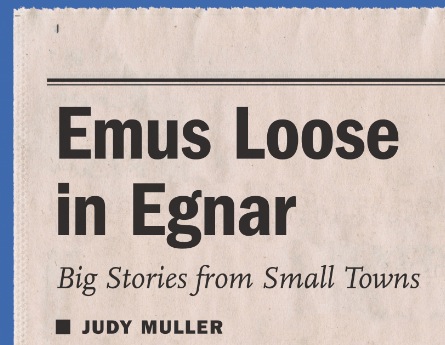
These days, small papers such as this one occasionally suffer crises of vocation. If one listens only to the lamentations of major-market media, one has to conclude that newspaper work is in its death throes.
As New Yorkers, we might pick up a newspaper in a fit of nostalgia or when we need to box our breakables, but in general, it is a far-from-essential part of our daily routine. This is the era of Twitter feeds and 24-hour cable news, after all. What need do we, technological sophisticates, have for a thick stack of broadsheet pages that you actually have to pay for?
Judy Muller understands the travails of the modern journalist as well as anyone. She is a Peabody Award-winning reporter and associate professor at the Annenberg School for Communication and Journalism at the University of Southern California. So when Muller writes in her new book, Emus Loose in Egnar: Big Stories from Small Towns, that in some places around the country “the weekly newspaper is not just surviving, but thriving,” she knows what she’s talking about.
Emus Loose in Egnar is a kind of Blue Highways for small papers. It celebrates the newspaper’s role in rural American life and profiles the colorful characters who run them.
Take M. E. Sprengelmeyer for instance. In an all-too-common story, Sprengelmeyer lost his job as the Washington correspondent for the Rocky Mountain News when the large Denver paper folded in 2009.
But rather than sending his resume and clips to other, also-struggling city papers, he packed up and moved to the little town of Santa Rosa, New Mexico, bought its 2,000-circulation Guadalupe County Communicator, and took over as publisher, editor, head writer, sometimes ad salesman, and newspaper deliveryman.
As Muller writes, “Issue after issue has featured …professional coverage of local events and people, with stunning photos to match.” The quality of Sprengelmeyer’s journalism has so invigorated Santa Rosa’s local media that the editor of the town’s other paper has gone so far as to say, “M. E. is making me a better newspaper man.”
Or take the current editor of the Canadian Record of Canadian, Texas, Laurie Ezzell Brown. She belongs to the second generation of Ezzells to own the paper and continues the family tradition of “practicing the First Amendment with…gusto.” The Canadian Record has a long history of left-leaning firebrand journalism that has sometimes inflamed its conservative Texas audience. But despite the conflict, “Thursday morning, when the papers are delivered…the residents of Canadian start showing up early to get their copies. Parking becomes a problem. The residents here are hungry for local news, the kind that no other outlet can provide.”
Muller quotes one Canadian resident as saying, “If there were no paper…no one would know about community and school events and the politicians would know that no one was watching.”
Emus Loose in Egnar is full of tales like these. While their big-city counterparts are struggling to compete with emerging media and withering under the influence of mega-conglomerate corporate ownership, small-town newspapers remain powerful forces of influence.
In local communities, the paper (“my paper,” as rural weeklies are ubiquitously called) serves a vital democratic function, holding the powerful accountable and speaking out for the interests of the powerless.
Even for rural papers, though, the Web beckons.
“[Online is] the future whether we like it or not,” Muller says. “That’s the truth. Weeklies are well advised to look ahead. Out there in the hinterlands, even those who like to hold the paper and to cut out articles are going the way of online. To ignore that is folly.”
But she believes small papers are uniquely situated for the future. “I think by definition anything that is hyper-local is one of the best business models for success right now. [Small papers] keep staff small and overhead low, but obviously they have a captive audience and a somewhat captive advertising base. That’s how they stay in business. It’s tight; sometimes they are just two major advertisers away from bankruptcy. But they stay in business.”
For media watchers, Muller’s book acts as a radical rebuttal to the accepted wisdom about the future of the newspaper industry. For others, it serves as a vivid portrait of the characters and concerns that define small-town life. And for those of us who work on small papers of our own (though we may live in the big city of Brooklyn, New York), it offers a heartening reminder of why we do this job in the first place.
Leave a Reply